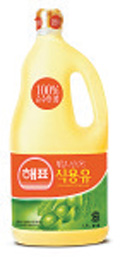Cool beans: Soy at heart of company’s cooking oil

Haepyo
With that in mind, Shin Duk-kyun, who had 30 years of experience in the food industry, started a company ? eventually called Dongbang ? to develop a market for cooking oil made with beans. The new product, he thought, could kill two birds with one stone, offering up a cheaper way for Koreans to cook and at the same time supplying a large amount of bean leftovers ? once the oils were squeezed out ? to livestock farms.
But it wasn’t as easy as it initially seemed. For one, building a plant to produce cooking oil made from beans was expensive. Shin managed to clear that hurdle by scraping together enough money to build a plant in Jinhae, South Gyeongsang, selling several real estate properties, taking out a $2.2 million loan and amassing 1 billion won ($800,929) in capital in Korea.
The company, however, quickly faced another problem. In November 1969, the ship that was delivering equipment for the plant from Israel sank. While insurance covered the cost of new equipment, construction of the plant was delayed a year.
Alas, yet another challenge soon presented itself.
The process of making the product ? which involves collecting soy oil by heating and pressing imported beans, peeling off the skin and mixing them with volatile solvent ? proved to be expensive. Shin had difficulty lowering costs of the oil, named Haepyo, as 22 to 23 liters of solvent was needed to process 1 ton of oil.
This could have been a deal-breaker. But after months of intense research, the company discovered an important fact.
“After taking out the air and creating a vacuum, you needed just five liters of solvent to create 1 ton” of oil, said Shin Seok-man, head of the Sajo Haepyo plant.
The oil debuted in 1971 with the slogan “clear and refreshing.” It was an instant hit, quickly gobbling up 70 percent of the market.
The supply of gas in households and the improvement of living standards ? which allowed locals to eat more types of dishes ? contributed to the sale of the cooking oil. Dongbang later changed its name to Shin Dongbang. The Haepyo brand almost disappeared into the history books in 1997 during the financial crisis. However, it was purchased by Sajo Group in 2004 and today ranks as one of the top cooking oils in Korea.
By Choi Ji-young [ojlee82@joongang.co.kr]










with the Korea JoongAng Daily
To write comments, please log in to one of the accounts.
Standards Board Policy (0/250자)